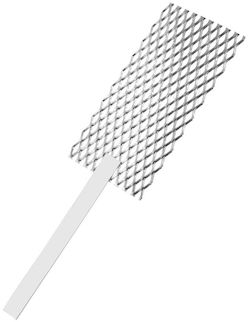
Curated with aloha by
Ted Mooney, P.E. RET

The authoritative public forum
for Metal Finishing 1989-2025

-----
Hexavalent chromium released from stainless steel parts
Q. A client of ours needs to test stainless steel tools they make for the medical and pharmaceutical industry for hexavalent chromium to show that none is emitting from the surface of the tools. They are looking for a GM method where you boil the parts in deionized water, add acid, then add and indicator and analyze the sample for hexavalent chromium using spectrophotometry. We can't find this method. Has anyone heard of such a method and know where I might get a copy? Or heard of a similar method for analyzing hexavalent chromium? Any help would be appreciated.
Lorri White- Durham, North Carolina
2005
AWWA

on AbeBooks
or eBay or
Amazon
(affil links)
A. The indicator you are looking for is called 1,5 diphenylcarbohydrazide [affil links]. It reacts with hexavalent chromium in solutions at low pH (~ 1.0) yielding a red violet color.
Methods for the determination of hex chrome in water can be found in various methods manuals, including "Standard Methods for the Examination of Water and Wastewater" ⇨

Dave Wichern
Consultant - The Bronx, New York
A. The test method you're referring to is GMW 3034. IMR Test Labs in Lansing N.Y. has processed material under this method for us. The detection limit for the analysis is 0.01 micrograms per gram (ppm).
Steve Richardson- Randolph, Massachusetts
A. You might well be able to get hex chrome from the surface of parts that have been plated then chromated, but there's no way that you can get hex chrome from stainless steel. The realities of physics and chemistry shouldn't be ignored - why waste time and money testing for something that cannot possibly be there?

Bill Reynolds [deceased]
consultant metallurgist - Ballarat, Victoria, Australia
We sadly relate the news that Bill passed away on Jan. 29, 2010.
A. I know this is an old thread, but as someone who has achieved some notoriety in the field of hexavalent chromium, I thought I would put in my two cents worth. Stainless steel is 'stainless' because the oxide film is thin and highly adherent. It is produced by the oxidation of the surface. In order to passsivate the surface, it is generally treated with a passivation solution, which can be (see ASTM A967 for details) - nitric acid plus sodium dichromate, nitric acid, or citric acid . It is uncommon today, but not unknown, to use nitric acid and sodium dichromate. Inadequate rinsing would leave hexavalent chromium on the surface of the part. By the way, in case anyone is interested, stainless steel does not generate hexavalent chromium (to the best of my knowledge and experience) in the ASTM B117 Salt Spray Test.

Tom Rochester
CTO - Jackson, Michigan, USA
Plating Systems & Technologies, Inc.

2007
Q. Thanks guys for your input on this matter. I'll really appreciate if you can answer my question; IS IT POSSIBLE THAT HEXAVALENT CHROMIUM GAS CAN BE DEVELOPED IN A UNIT THAT IS BEEN MADE IT OUT OF STAINLESS STEEL, AND ALSO BEEN CHARGED CONSTANTLY WITH ELECTRICITY? (send me please an answer asap, Thanks again
JUAN CARLOS JOFRE- Albany, Georgia
October 5, 2009
A. Hi, Juan. If we omit the 'electrical' portion of your question it has already been answered. However I hesitate to say 'a unit ... charged with electricity' will not develop hexavalent chromium because 'unit' and 'charged with electricity' are awfully broad terms. I believe if the stainless steel is the anode in a circuit that it can dissolve as hexavalent chromium :-)
Hexavalent chromium is not a gas, however, it is an ion dissolved in a water-based solution, but it is possible for droplets or mists of the solution to be entrained in a gas in champagne or ginger ale style.
Regards,

Ted Mooney, P.E.
Striving to live Aloha
finishing.com - Pine Beach, New Jersey
A. Basically no, it's not possible in a closed unit.
We need to know more about the "unit" ... is water/fluid/gas running through it? Is this electricity heating it? If it, or any of its components are chrome plated? Are you running acids through it? etc
If it's just a stainless steel bowl with stainless steel stuff, then it's not even worth testing.
- Sydney, NSW Australia
January 8, 2012
Q. I have a question somewhat similar to this, hope you guys can help me; I have searched around without any luck and I'm no chemist:-)
I want to do rust removal by electrolysis (sodium carbonate
⇦ this on
eBay or
Amazon]
, water solution). Can I use a stainless steel basket as CATHODE or will it produce Cr VI ?
I Know if I use stainless steel as anode it does produce Cr6 but what if it is a stainless cathode ?
I have a small solution of Sodium carbonate, water and hexavalent chromium ... What can I do to eliminate the chromium or make it safe, preferably safe enough to dump in the drain? ... sodium meta-bisulfite, or ascorbic acid? Will that work for me ?
- Roedekro Denmark
September 18, 2016
A. Hi Kristian. The cathode is the negative pole and has a surfeit of electrons rather than a deficit, so it offers reductive rather than oxidative potentials. No, a stainless steel cathode will not produce hexavalent chromium, nor even trivalent chromium.
What can be discharged is the subject of local, regional, and national laws, and I don't know what you are allowed to do in Denmark, but I do not foresee any chromium in the waste. Hexavalent chrome even at very low concentrations will be amber or orange. Good luck.
Regards,

Ted Mooney, P.E. RET
Striving to live Aloha
finishing.com - Pine Beach, New Jersey
A. Why not just use mild steel cathodes? SS will work and should not create any soluble hexavalent chromium as long as it never becomes anodic, but steel works too.
Lyle KirmanConsultant - Cleveland Heights, Ohio, USA
![]() Plan is to use a kitchen steamer ss mesh basket to hold a lot of small parts, screws, washers and so on ... it takes way too long to connect every single part.
Plan is to use a kitchen steamer ss mesh basket to hold a lot of small parts, screws, washers and so on ... it takes way too long to connect every single part.
There are a lot of warnings on the web against using stainless steel in a setup like this. The claim is that using SS as an anode will produce Cr6.
I'm not a chemist and my knowledge about chemistry somewhat limited too ... it's magic, and Cr6 is no good.
So in order to avoid producing toxic waste I searched around and found nothing on electrolysis using a SS cathode except warnings for ss anodes.
However this entire conversation before my question was very informative and I now have a pretty good idea what to do.
I appreciate your answers guys. Thanks
- Roedekro Denmark
|
Q. I have a question, I'm no chemist, I've never plated chromium. I was plating nickel chloride in HCl acid, with a Nickel anode. The anode ran out so I put a new one in, then the anode started to turn the solution black with voltage, and red without voltage; I'm suspecting my last anode is not nickel. - bellingham, Washington, USA July 31, 2018 A. Hi Johnny. If you switch back to a nickel anode the solution will probably eventually turn green again, but that doesn't necessarily mean it's useable. Contaminants can sometimes ruin nickel plating at parts-per-million concentration ranges. We have almost countless threads on various aspects of nickel plating here. I hope you are doing your learning experiments on scrap rather than on actual parts because the odds of success on your early experiments are close to zero whereas the odds of permanently ruining the parts are quite high. Plating from a nickel chloride bath is difficult and the tensile stress will be very high, so flaking of the plating is a possibility. Sorry, but I can't guess what metal you used as an anode based on what color it turned the solution. Good luck. Regards,  Ted Mooney, P.E. RET Striving to live Aloha finishing.com - Pine Beach, New Jersey
- bellingham, Washington, USA |
Q. Hello,
Maybe I am lucky and I get a useful reply in this post ;-)
I want to add Oxygen to my fresh water planted aquarium via electrolysis of its aquarium water. This means that Anode and Cathode are both placed in the tank and I do not have to create any dangerous byproduct for me or the fish.
The aquarium water is quite hard water:
- pH 8.4 (which I bring down to a pH of about 7 by adding a calculated dose of H2SO4)
- During light time CO2 gas is added and the pH drops to about 6; During night CO2 is stopped and pH slowly rises back to about 7.
- 160 ppm of bicarbonates (negligible carbonates)
- 50 mg/l of Na and 50 mg/l of Cl; TDS of tap water is 270 ppm. After adding H2SO4 and all the typical plants nutrients I get to a TDS of about 400.
I have just started to use two fine grids (about 1 mm or maybe even less spacing texture), both sized 20 cm x 10 cm, spaced by about 0.5 cm from each other. Both are made of stainless steel.
I am using 12V with 1 A power supply, which generates quite a satisfactory amount of visible H2 and O2 bubbles.
But just after a few hours of using it, I accidentally read about the risks of Cr6, which is created at the anode when stainless steel is used.
Is this really an issue? Is Cr6 always a by-product at the anode if stainless steel is used?
Would a different voltage, Ampere, spacing of grids, etc., make sure that Cr6 is never created?
If Cr6 is always a by-product when stainless steel is used as anode, would a bar of pure magnesium connected to the stainless steel anode avoid Cr6? The idea is to corrode that bar instead of the stainless steel. But would that mean that only the magnesium gets corroded or this would only partially limit the corrosion of the stain steel into Cr6?
Are there strict requirements where to place this magnesium bar, or just common sense to get it as close as possible to the anode is good enough?
Any other material I could use as anode, without spending a fortune? How much does a small (say 5x5 cm) titanium coated with platinum electrode cost? It is full of Chinese stuff online which I do not trust.
Thanks very much in advance for any help on this subject!
Regards,
Dav
P.S.: Yes, I want a DYI and I do not want to buy Twinstar or Chiros products even if the DIY one will cost me more! ;-)
- Holland
August 24, 2023
A. Hi Dav,
If you want to involve DIY stuff, you could get carbon rods from carbon-zinc batteries as your electrodes although the surface area would be low.
I believe that, unfortunately, stainless steel as an anode can in fact put hexavalent chromium into solution. You can look in Amazon or Grobet for platinum coated electrodes -- they are expensive. 2" x 3" almost $100 at Grobet; much cheaper at Amazon but I think you're right to be suspect of their quality :-)
Luck & Regards,

Ted Mooney, P.E. RET
Striving to live Aloha
finishing.com - Pine Beach, New Jersey
Q, A, or Comment on THIS thread -or- Start a NEW Thread
